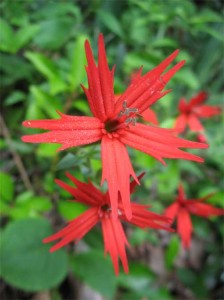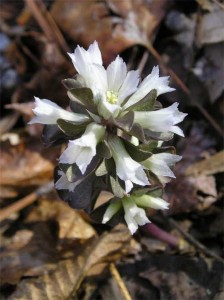B.W. Wells gained power from a flower

Late spring-flowering fire pink inspired B.W. Wells to become a botanist. Photo by Tom Wentworth
By Ken Moore
In 1932, The Natural Gardens of North Carolina, written by Dr. Bertram Whittier (B.W.) Wells, professor of botany at N.C. State University, was published by the University of North Carolina Press. How well I remember, back in 1966, my mentor presenting me with a copy of Natural Gardens with the comment, “If you are going to study the botany of North Carolina, then you need to become acquainted with B. W. Wells!†That began for me a life-long pursuit of discovering and enjoying the natural gardens of our state.
As a high school freshman in Ohio, B.W., with the help of a plant key, saw and identified a fire pink, Silene virginica, a brilliant red wildflower we can discover in our North Carolina forests in early May.
B.W.’s discovery is worth describing:
“One day, a week into the botany course, he spied a brilliant scarlet flower while walking along a creek bank. Strangely struck by it, he opened his manual of plants and attempted his first identification by means of a descriptive key. A thrill of triumph surged through him when he successfully found that the plant was known as the fire pink. ‘From that moment on I knew what my life’s work would be. I was so terribly excited about identifying that flower. And I’m still as excited as ever about botany. The more you see, the more you have to see.’†(From Nature’s Champion: B.W. Wells, Tar Heel Ecologist by James R. Troyer.)
B.W. went on to receive his Ph.D. at the University of Chicago and in 1919 accepted an appointment at N.C. State College (now University) where he remained as head of the botany department until 1949 and professor until 1954.
Immediately, he was inspired and challenged by the beauty and diversity of North Carolina plants and plant communities. He was an engaging teacher and a competent researcher, making great contributions to the new discipline of plant ecology. He was an excellent communicator and writer. Natural Gardens is a very readable description of the natural vegetation of North Carolina, east to west, from the ocean spray dunes to the high-mountain evergreen forests. For him, the diversity of seasonal wildflower displays in distinct plant communities across the state were, indeed, spectacular natural gardens.
Some of his notable observations include salt spray effects on coastal vegetation, meteorite origin of the hundreds of elliptical shaped Carolina bay lakes and bogs in the coastal plain and Native American burning practices as origins of high-mountain balds. He encouraged nurserymen to propagate the great variety of native plants for home garden and urban landscape use.
He was way ahead of his time!
In retirement, he remained physically active, farming an old homestead above a dramatic bend of the Neuse River near Wake Forest. When not engaged in farm work or laying out walking trails through his natural gardens, he painted with water colors, oils and pastels – over 100 beautiful portraits of the state’s natural gardens, including his own Rock Cliff Farm. Fortunately, with support from The B.W. Wells Association,
Rock Cliff Farm is now a part of the Falls Lake State Recreational Area.
Make note: Rock Cliff Farm, including his self-built artist studio and miles of trails, will be open to the public for B.W. Wells Heritage Day this Saturday, March 28. Visit www.bwwells.org for directions and descriptions of activities, including wildflower, geology and heritage farm tours and special activities for children.
As I was counseled back in 1966, if you want to appreciate the plants of North Carolina, you need to become acquainted with B.W. Wells’ Natural Gardens. A recently updated edition by UNC Press is available at local book stores. And remember: “The more you see, the more you have to see.â€

B.W. Wells in 1955, when he began retirement from botany to farm, blaze walking trails and paint landscapes for the next 23 years.
Photo courtesy B.W. Wells Association archives

The elusive early spring-flowering pennywort will be seen on wildflower walks this Saturday at B.W. Wells Heritage Day. Photo by Dave Otto


Comments are closed.